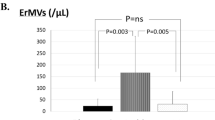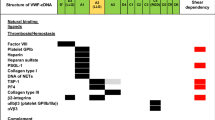Abstract
Elevated von Willebrand factor (vWF):Antigen plasma levels have been observed in conjunction with cardiovascular diseases or vasculitis. The association of Kawasaki disease, a vascular inflammatory disease and vWF:Antigen, vWF:Collagen binding activity, and vWF multimers is unknown. We therefore investigated vWF parameters in 28 patients with acute Kawasaki disease in association with disease activity and coronary artery lesions. VWF:Antigen and vWF:Collagen binding activity were assessed via enzyme-linked immunoassay. The ratio of both (vWF:Collagen binding activity and VWF:Antigen) was calculated and vWF multimeric structure analysis performed. We analyzed the association between vWF parameters and our clinical data focusing on coronary artery outcome. VWF:Antigen and vWF:Collagen binding activity levels were significantly higher in the acute than in the disease’s convalescence phase, and correlated positively with CRP levels. Neither variable was associated with coronary artery lesions. The vWF:Collagen binding activity/vWF:Antigen ratio, however, was significantly decreased in patients with a coronary artery lesion (z-score > 2; N = 10; mean ratio 0.96 vs. 0.64; p = 0.031) and even more so in those with a coronary artery aneurysm (z-score > 2.5; N = 8; mean ratio 0.94 vs. 0.55; p = 0.02). In a sub-analysis, those patients with a very low ratio in the acute phase presented a persistent coronary artery aneurysm at their 1-year follow-up.
Conclusion: This study suggests that comprehensive analysis of vWF parameters may help to both monitor KD inflammation and facilitate the identification of those patients carrying an increased risk for coronary artery lesion.
What is Known: • Von Willebrand factor (VWF)-parameters represent surrogate markers for vascular inflammation. • Kawasaki disease is a generalized vasculitis in children, which can be complicated by coronary artery lesions. | |
What is New: • In those Kawasaki disease patients with coronary artery lesions, the vWF:CB/vWF:Ag ratio was significantly decreased. • VWF parameters may help to identify patients at risk for coronary artery lesions. |



Similar content being viewed by others
Abbreviations
- AHA:
-
American Heart Association
- ALAT:
-
Alanine aminotransferase
- ASAT:
-
Aspartate aminotransferase
- CRP:
-
C-reactive protein
- ELISA:
-
Enzyme-linked immunoassay
- ESPED:
-
German Pediatric Surveillance Unit
- ESR:
-
Erythrocyte sedimentation rate
- Gamma GT:
-
Gamma-glutamyltransferase
- IVIG :
-
Intravenous immunoglobulin
- KD:
-
Kawasaki disease
- PVDF:
-
Polyvinylidene difluoride
- SD:
-
Standard deviation
- TNFα:
-
Tumor necrosis factor α
- vWF:
-
von Willebrand factor
- vWF:Ag:
-
von Willebrand factor: antigen
- vWF:CB:
-
von Willebrand factor: collagen binding
References
Ayusawa M, Sonobe T, Uemura S, Ogawa S, Nakamura Y, Kiyosawa N, Ishii M, Harada K, Kawasaki Disease Research Committee (2005) Revision of diagnostic guidelines for Kawasaki disease (the 5th revised edition). Pediatrics international : official journal of the Japan Pediatric Society 47(2):232–234
Bernardo A, Ball C, Nolasco L, Moake JF, Dong JF (2004) Effects of inflammatory cytokines on the release and cleavage of the endothelial cell-derived ultralarge von Willebrand factor multimers under flow. Blood. 104(1):100–106
Bernardo A, Ball C, Nolasco L, Choi H, Moake JL, Dong JF (2005) Platelets adhered to endothelial cell-bound ultra-large von Willebrand factor strings support leukocyte tethering and rolling under high shear stress. JTH. 3(3):562–570
Dallaire F, Dahdah N (2011) New equations and a critical appraisal of coronary artery Z scores in healthy children. Journal of the American Society of Echocardiography : official publication of the American Society of Echocardiography 24(1):60–74
Dietz SM, van Stijn D, Burgner D, Levin M, Kuipers IM, Hutten BA, Kuijpers TW (2017) Dissecting Kawasaki disease: a state-of-the-art review. Eur J Pediatr 176(8):995–1009
Fabi M, Andreozzi L, Corinaldesi E, Bodnar T, Lami F, Cicero C, Tchana B, Landini C, Sprocati M, Bigucci B, Balsamo C, Sogno Valin P, di Fazzio G, Iughetti L, Valletta E, Marchetti F, Donti A, Lanari M (2019) Inability of Asian risk scoring systems to predict intravenous immunoglobulin resistance and coronary lesions in Kawasaki disease in an Italian cohort. Eur J Pediatr 178(3):315–322
Hillgruber C, Steingraber AK, Poppelmann B, Denis CV, Ware J, Vestweber D et al (2014) Blocking von Willebrand factor for treatment of cutaneous inflammation. The Journal of investigative dermatology 134(1):77–86
Irazuzta JE, Elbl F, Rees AR (1990) Factor VIII related antigen (von Willebrand’s factor) in Kawasaki disease. Clin Pediatr 29(6):347–348
Jakob A, Whelan J, Kordecki M, Berner R, Stiller B, Arnold R, von Kries R, Neumann E, Roubinis N, Robert M, Grohmann J, Höhn R, Hufnagel M (2016) Kawasaki disease in Germany: a prospective, population-based study adjusted for underreporting. Pediatr Infect Dis J 35(2):129–134
Jakob A, von Kries R, Horstmann J, Hufnagel M, Stiller B, Berner R, Schachinger E, Meyer K, Obermeier V (2018) Failure to predict high-risk Kawasaki disease patients in a population-based study cohort in Germany. Pediatr Infect Dis J 37(9):850–855
Lenting PJ, Casari C, Christophe OD, Denis CV (2012) von Willebrand factor: the old, the new and the unknown. JTH 10(12):2428–2437
Leung DY, Cotran RS, Kurt-Jones E, Burns JC, Newburger JW, Pober JS (1989) Endothelial cell activation and high interleukin-1 secretion in the pathogenesis of acute Kawasaki disease. Lancet (London, England) 2(8675):1298–1302
Li X, Chen Y, Tang Y, Ding Y, Xu Q, Sun L, Qian W, Qian G, Qin L, Lv H (2018) Predictors of intravenous immunoglobulin-resistant Kawasaki disease in children: a meta-analysis of 4442 cases. Eur J Pediatr 177(8):1279–1292
Lin MT, Tsao LY, Cheng ML, Chang YJ, Chiu HY, Chen HN, Kuo SF, Chiou SJ (2005) Absence of hypercoagulability in acute Kawasaki disease. Pediatrics international : official journal of the Japan Pediatric Society. 47(2):126–131
McCrindle BW, Rowley AH, Newburger JW, Burns JC, Bolger AF, Gewitz M, Baker AL, Jackson MA, Takahashi M, Shah PB, Kobayashi T, Wu MH, Saji TT, Pahl E, American Heart Association Rheumatic Fever, Endocarditis, and Kawasaki Disease Committee of the Council on Cardiovascular Disease in the Young; Council on Cardiovascular and Stroke Nursing; Council on Cardiovascular Surgery and Anesthesia; and Council on Epidemiology and Prevention (2017) Diagnosis, treatment, and long-term management of Kawasaki Disease: a scientific statement for health professionals from the American Heart Association. Circulation. 135(17):e927–e999
Nakamura Y, Yashiro M, Uehara R, Sadakane A, Tsuboi S, Aoyama Y, Kotani K, Tsogzolbaatar EO, Yanagawa H (2012) Epidemiologic features of Kawasaki disease in Japan: results of the 2009-2010 nationwide survey. J Epidemiol 22(3):216–221
Nash MC, Shah V, Dillon MJ (1995) Soluble cell adhesion molecules and von Willebrand factor in children with Kawasaki disease. Clin Exp Immunol 101(1):13–17
Petri B, Broermann A, Li H, Khandoga AG, Zarbock A, Krombach F, Goerge T, Schneider SW, Jones C, Nieswandt B, Wild MK, Vestweber D (2010) von Willebrand factor promotes leukocyte extravasation. Blood. 116(22):4712–4719
Pottinger BE, Read RC, Paleolog EM, Higgins PG, Pearson JD (1989) von Willebrand factor is an acute phase reactant in man. Thromb Res 53(4):387–394
Ritz N (2017) Kawasaki disease: what the paediatrician needs to know. Eur J Pediatr 176(8):1011
Tanoshima R, Hashimoto R, Suzuki T, Ishiguro A, Kobayashi T (2019) Effectiveness of antiplatelet therapy for Kawasaki disease: a systematic review. Eur J Pediatr 178(6):947–955
Taubert KA, Shulman ST (1999) Kawasaki disease. Am Fam Physician 59(11):3093–3102 3107-3098
Wardle AJ, Connolly GM, Seager MJ, Tulloh RM (2017) Corticosteroids for the treatment of Kawasaki disease in children. The Cochrane database of systematic reviews 1:Cd011188
Funding
André Jakob received funding for this work by a grant from the German Heart Foundation.
Author information
Authors and Affiliations
Contributions
André Jakob: Conceived and designed the study, contributed to statistical analyses and data interpretation, drafted the manuscript and approved the final manuscript as submitted.
Eva Schachinger: Responsible for data collection, contributed to statistical analysis and study design, as well as approved the final manuscript as submitted.
Simon Klau: Conducted the statistical analysis, contributed to drafting the manuscript and approved the final manuscript as submitted.
Anja Lehner, Sarah Ulrich and Brigitte Stiller: Contributed to data interpretation, served on the adjudicating committee and approved the final manuscript as submitted.
Barbara Zieger: Contributed to the study design, data interpretation and statistical analysis. She is responsible for the VWF analyses and contributed to drafting the manuscript; she has approved the final manuscript as submitted.
Corresponding author
Ethics declarations
Conflict of interest
The authors declare that they have no conflict of interest.
Ethical approval
Approval for our study had been provided by the Ethics Committee of the University of Freiburg, in accordance with Declaration of Helsinki ethical standards.
Informed consent
Informed consent was obtained from all individual participants included in this study.
Additional information
Communicated by Peter de Winter
Publisher’s note
Springer Nature remains neutral with regard to jurisdictional claims in published maps and institutional affiliations.
Clinical Trial Registration: German clinical trial registration, DRKS00010071 http://apps.who.int/trialsearch/Trial2.aspx?TrialID=DRKS00010071
Rights and permissions
About this article
Cite this article
Jakob, A., Schachinger, E., Klau, S. et al. Von Willebrand factor parameters as potential biomarkers for disease activity and coronary artery lesion in patients with Kawasaki disease. Eur J Pediatr 179, 377–384 (2020). https://doi.org/10.1007/s00431-019-03513-6
Received:
Revised:
Accepted:
Published:
Issue Date:
DOI: https://doi.org/10.1007/s00431-019-03513-6




